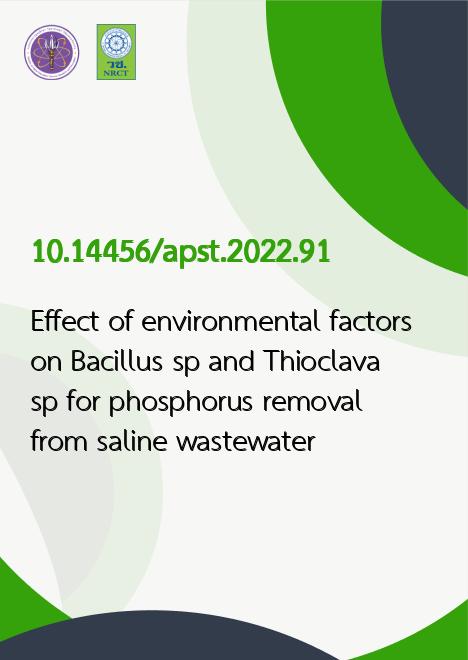
|
Effect of environmental factors on Bacillus sp. and Thioclava sp. for phosphorus removal from saline wastewater |
|---|---|
| รหัสดีโอไอ | |
| Creator | Tsuyoshi Ima |
| Title | Effect of environmental factors on Bacillus sp. and Thioclava sp. for phosphorus removal from saline wastewater |
| Contributor | Rafitah Hasanah |
| Publisher | Asia-Pacific Journal of Science and Technology |
| Publication Year | 2565 |
| Journal Title | Asia-Pacific Journal of Science and Technology |
| Journal Vol. | 27 |
| Journal No. | 6 |
| Page no. | 10 |
| Keyword | Environmental factors, Bacillus sp., Thioclava sp., Phosphorus, Saline wastewate |
| URL Website | https://www.tci-thaijo.org/index.php/APST |
| Website title | https://so01.tci-thaijo.org/index.php/APST/article/view/262625 |
| ISSN | 2539-6293 |
| Abstract | In this study, Bacillus sp. (TR1) and Thioclava sp. (MA3) were assessed for their abiotic adaptability and phosphorus removal efficiency in saline wastewater. The effects of abiotic factors such as carbon source, pH, temperature, and salinity on bacterial growth were examined through a series of batch experiments. Both bacteria used carbon sources such as glucose, sucrose, and CH3COONa for their growth. The pH study indicated that Bacillus sp. (TR1) preferred the pH range of 68 and Thioclava sp. (MA3) preferred the pH range of 69. Bacillus sp. favorably multiplied in the temperature range of 2540 ?C, while 2535 ?C was preferred by Thioclava sp. Salinity range of 0%10% was favorable for TR1, with optimum growth observed at 3.5%5%, and Thioclava sp. (MA3) preferred the salinity range of 1%10% with optimal growth at 4% but was absent in non-saline water. Bacillus sp. and bacterial combination (TR1 and MA3) showed similar values for phosphorus removal efficiency (100%) at 1.0 mg-P/L total P compared to Thioclava sp. (38.2%). The initial phosphorus concentration of 2.5 mg-P/L in combination showed a slightly higher 72.35% P removal efficiency compared to the individual strains. However, phosphorus removal did not increase, but showed a downward trend with increasing at initial phosphorus. The results demonstrated that when used individually, Bacillus sp. showed a reasonably high phosphorus removal ability than Thioclava sp., and exhibited good synergy when used in combination to remove phosphorus from saline wastewater. |